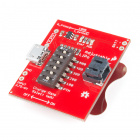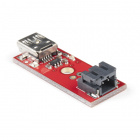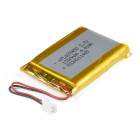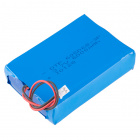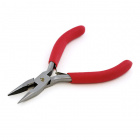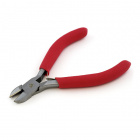Contributors:
 bboyho
bboyho Introduction
Lithium-Ion Polymer (LiPo) batteries are a favorite of ours. Very light weight and some of the highest energy densities available. We affectionately call this battery the 'car battery' because it's huge. Not physically (it's 110 grams!) but because this 6Ah LiPo in capable of outputting 6 Amps over the period of one hour! This is a very large amount of power in our low-power embedded world. Please don't confuse this with a real car battery!
A LiPo battery capable of producing 6 Amps for one hour!
Required Materials
To follow along with this tutorial, you will need the following materials at a minimum. You may not need everything though depending on what you have. Add it to your cart, read through the guide, and adjust the cart as necessary. Below is a wishlist of the parts that you need to get started if you were to charge a LiPo battery and then remove the connector.
Single Cell LiPo Chargers
There are a variety of development boards and breakout boards with a dedicated single cell LiPo battery charge circuit. Below are a few examples from the SparkFun catalog that have the MCP73831. The charge IC used and charge rate will depend on the design.
WRL-19177
The IoT RedBoard is an ESP32 WROOM-equipped development board that has everything you need in an Arduino Uno with extra perks…
PRT-14380
The SparkFun Adjustable LiPo Charger is a single-cell lithium polymer (LiPo) and lithium ion battery charger. Because it’s …
PRT-10401
If you need to charge LiPo batteries, this simple charger will do just that. It is designed to charge single-cell Li-Ion or L…
DEV-20748
The MicroMod Main Board is a specialized carrier board that allows you to interface a MicroMod Processor Board with a single …
Single Cell LiPo Battery
Of course, you will also need a single cell LiPo battery. Below are a few LiPo batteries to choose from in the SparkFun catalog.
PRT-13854
These are very slim, extremely light weight batteries based on Lithium Ion chemistry. Each cell outputs a nominal 3.7V at 850…
PRT-13851
This is a very small, extremely lightweight battery based on Lithium Ion chemistry, with the highest energy density currently…
PRT-18286
Slim, extremely light weight batteries based on Lithium Ion chemistry. Each cell outputs a nominal 3.7V at 1250 mAh and is IE…
Retired
PRT-13856
If you need some juice, this 6Ah Lithium Ion Battery is for you. These are very compact batteries based on Lithium Ion chemis…
Tools
Need some help removing the single cell LiPo battery from the JST connector? Try grabbing a needle nose plier or diagonal cutters. Or you can use a hobby knife to whittle down the JST-PH's locking tabs.
TOL-08793
Mini Pliers. These are great little pliers! A must have for any hobbyist or electrical engineer. Crucial for inserting device…
TOL-08794
Mini Diagonal Cutters. These are great little cutters! A must have for clipping leads and extra solder tails. 4" long.
TOL-09200
It's like an Xacto knife, only better. We use these extensively when working with PCBs. These small knives work well for cutt…
Note: If you decide to not use needle nose pliers, we recommend getting a low cost diagonal cutters instead of flush cutters. This will prevent users from damaging their nicer flush cutters when pulling the JST connector out.
You May Also Need
For strain relief, you can use some electrical tape and scissors to secure the wires on the single cell LiPo battery. You may want a marker to label the battery.
- Electrical Tape
- Scissors
- Marker
Suggested Reading
If you aren’t familiar with the following concepts, we also recommend checking out a few of these tutorials before continuing
Connector Basics
Connectors are a major source of confusion for people just beginning electronics. The number of different options, terms, and names of connectors can make selecting one, or finding the one you need, daunting. This article will help you get a jump on the world of connectors.
Battery Technologies
The basics behind the batteries used in portable electronic devices: LiPo, NiMH, coin cells, and alkaline.
How to Use a Multimeter
Learn the basics of using a multimeter to measure continuity, voltage, resistance and current.
What is a Battery?
An overview of the inner workings of a battery and how it was invented.


